These 8 Technique Drills Will Increase Your Speed
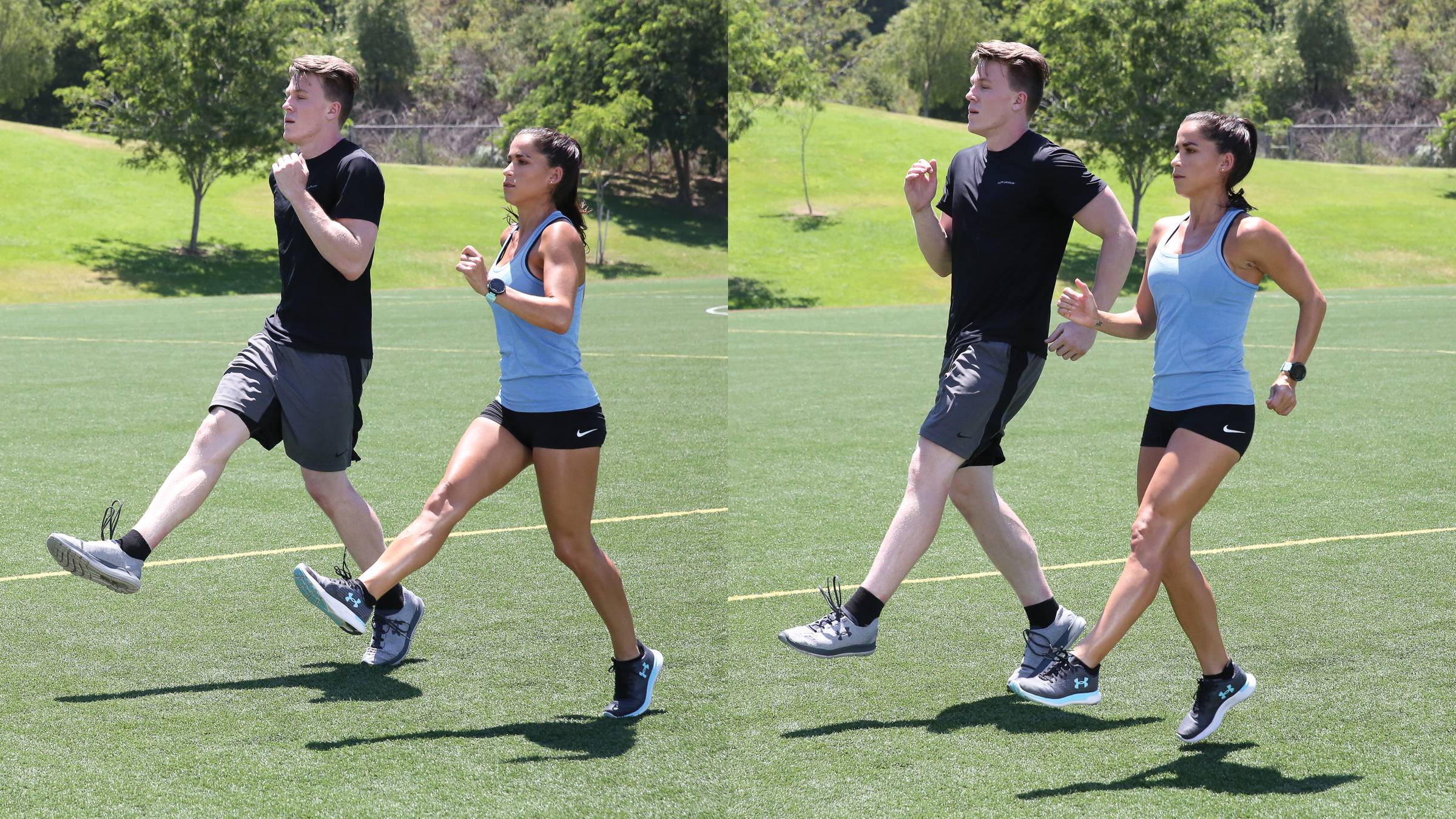
(Photo: Diana Hernandez)
Technique drills isolate and exaggerate elements of your sprinting gait cycle. Top speedsters have used them for generations to increase running speed. But that doesn’t mean they aren’t without controversy. Steve Magness writes on his blog, “Drills are not useful for improving mechanics because they do not replicate the running form biomechanically, neurally, or muscle recruitment wise.”
In contrast, Jay Dicharry has written that “individualized drills and neuromuscular activities . . . will train [runners] to use elastic recoil in gait.”
And a 2009 study concluded that a mix of running drills, agility exercises, and explosive starts led to “significant improvement” in the participants’ neuromuscular control. But the main reason you should include drills in your training is that the fastest men and women in the world include drills in theirs. When you perform your drills, keep in mind that the fast stride that follows each drill is essential to hardwiring the drills’ benefits into your sprinting performance.
A Note on Volume and Recovery
Most of the exercises and drills to help increase running speed offer a range for volume. Choose the volume that best represents your current fitness. New to training? Opt for the lower end when it comes to volume.
If you’re sharpening skills and fitness developed over the course of years, you may want to begin with more volume. Either way, your fitness and speed will improve, and you’ll soon be mastering more challenging workouts.
For recovery between sets, reps, and exercises, use this rule of thumb:
- 1–3 minutes of recovery following sets and single-rep exercises (e.g., a hill sprint)
- 10–30 seconds (or however long it takes you to switch exercises) during circuit training
That said, if you need more recovery time, take it. Remember, it’s not the training you do that counts; it’s the training from which your body can recover. If you overdo it, you won’t get faster; you’ll get injured, sick, or burned out.
Skipping
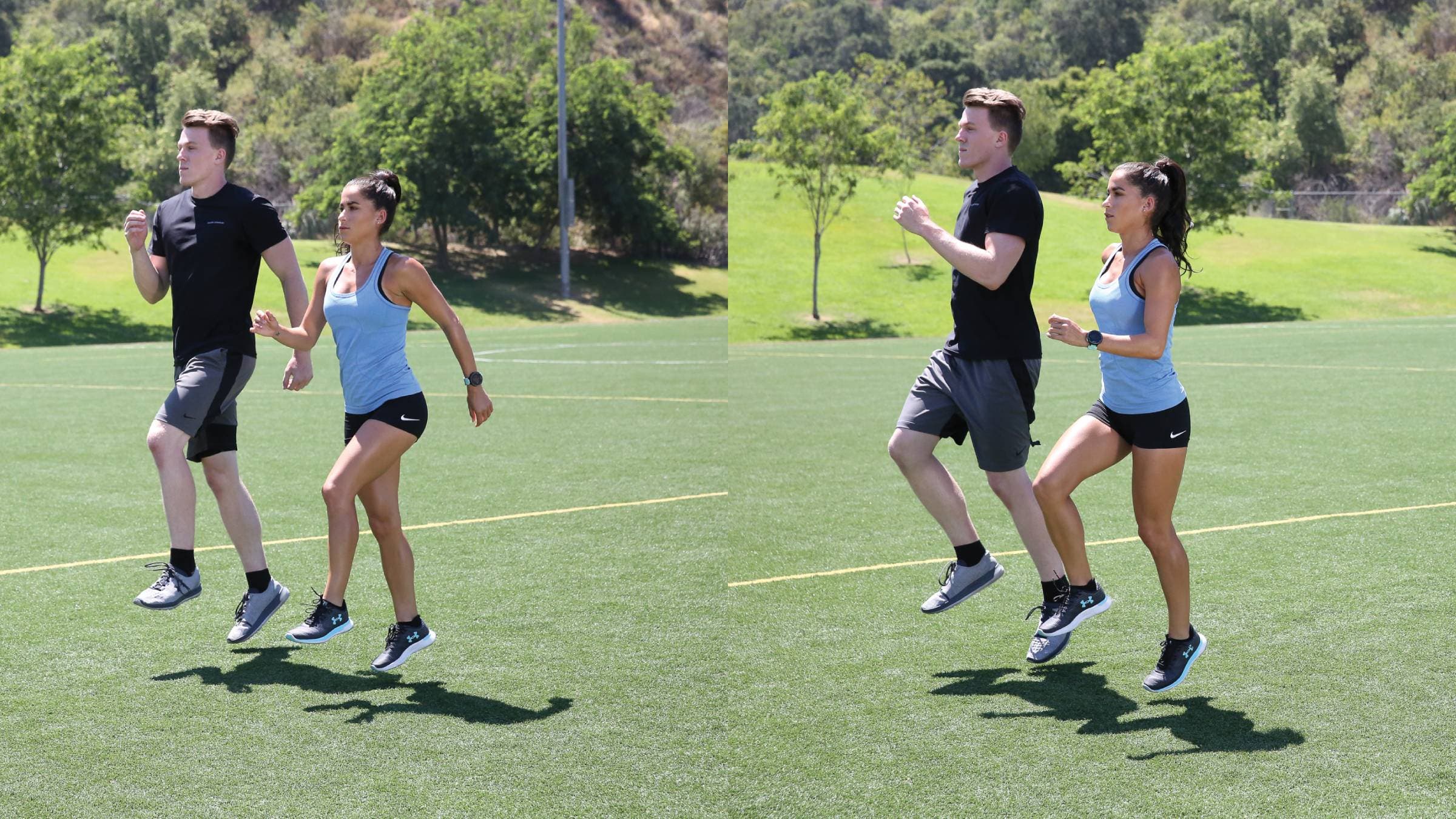
Photo: Diana Hernandez
This is the same schoolyard skipping you remember from childhood. Skipping stimulates elastic recoil and helps teach your body to “pop” off your toes with each stride. It also serves as a great warm up for the drills that follow.
1 rep of 20–60 yards
- Step forward with your right foot and spring vertically and horizontally, landing on the same (right) foot.
- Next, step forward with your left foot, and spring vertically and horizontally, landing on the same (left) foot.
- Step forward with your right foot, and continue the pattern.
- After completing the drill, jog back to your start line, then immediately perform a stride at 90% effort (same distance as drill), followed by a walk back to the start line.
High Skipping
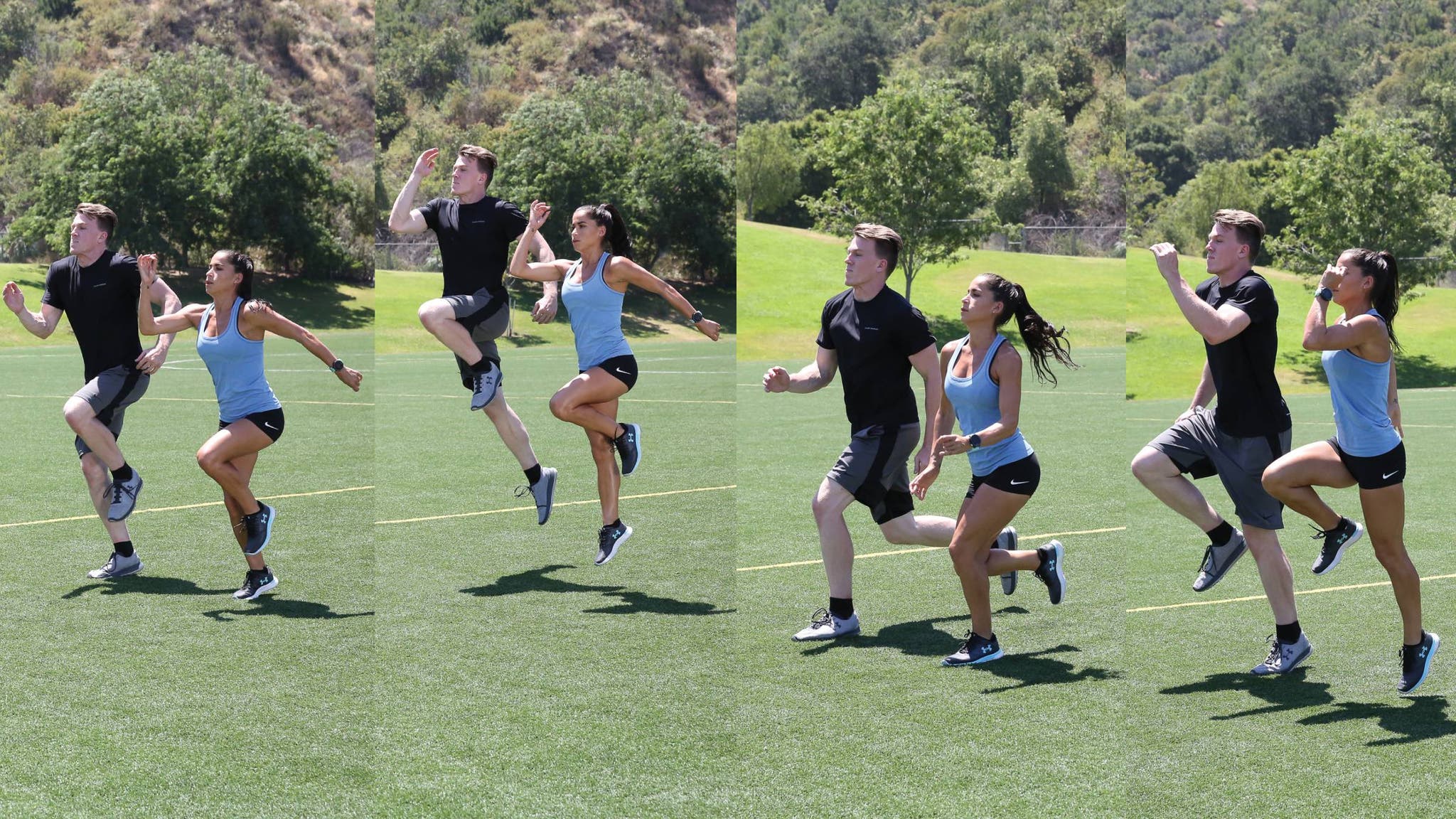
Photo: Diana Hernandez
This variation of skipping allows you to direct force in a vertical direction, while exaggerating concentric calf contribution and knee lift.
1 rep of 20–60 yards
- Step forward with your right foot and spring vertically off the ball of that foot, swinging your right arm in an exaggerated arc (your hand should end up near your forehead). Simultaneously lift your left knee high.
- Land on the same (right) foot, and then step forward with your left foot. Spring vertically off that foot, while lifting your right knee and left arm.
- Land on your left foot, step forward with your right foot, and continue the pattern.
- After completing the drill, jog back to your start line, then immediately perform a stride at 90% effort (same distance as drill), followed by a walk back to the start line.
Flat-Footed Marching

Photo: Diana Hernandez
“Knee lift position” largely controls how hard your foot hits the ground (by determining the distance you accelerate your foot downward)—and the key to maximum velocity is to hit the ground hard. This drill teaches your hip extensors “reduced inhibition” (a science-y way of saying less opposition from your glutes and hamstrings) while simultaneously training those same muscles to allow greater range of motion (i.e., a higher knee lift). That’s double-good news for knee lift.
1 rep of 20–60 yards
- March forward, lifting your right knee to waist-height or higher, maintaining a 90° angle at your ankle (in other words, don’t point your foot).
- Bring your right foot down, actively accelerating it toward the ground without stomping the ground. Land flatfooted, and then repeat with your left leg.
- Continue alternating legs, moving your arms in a running motion throughout the drill.
- After completing the drill, jog back to your start line, then immediately perform a stride at 90% effort (same distance as drill), followed by a walk back to the start line.
High Knees
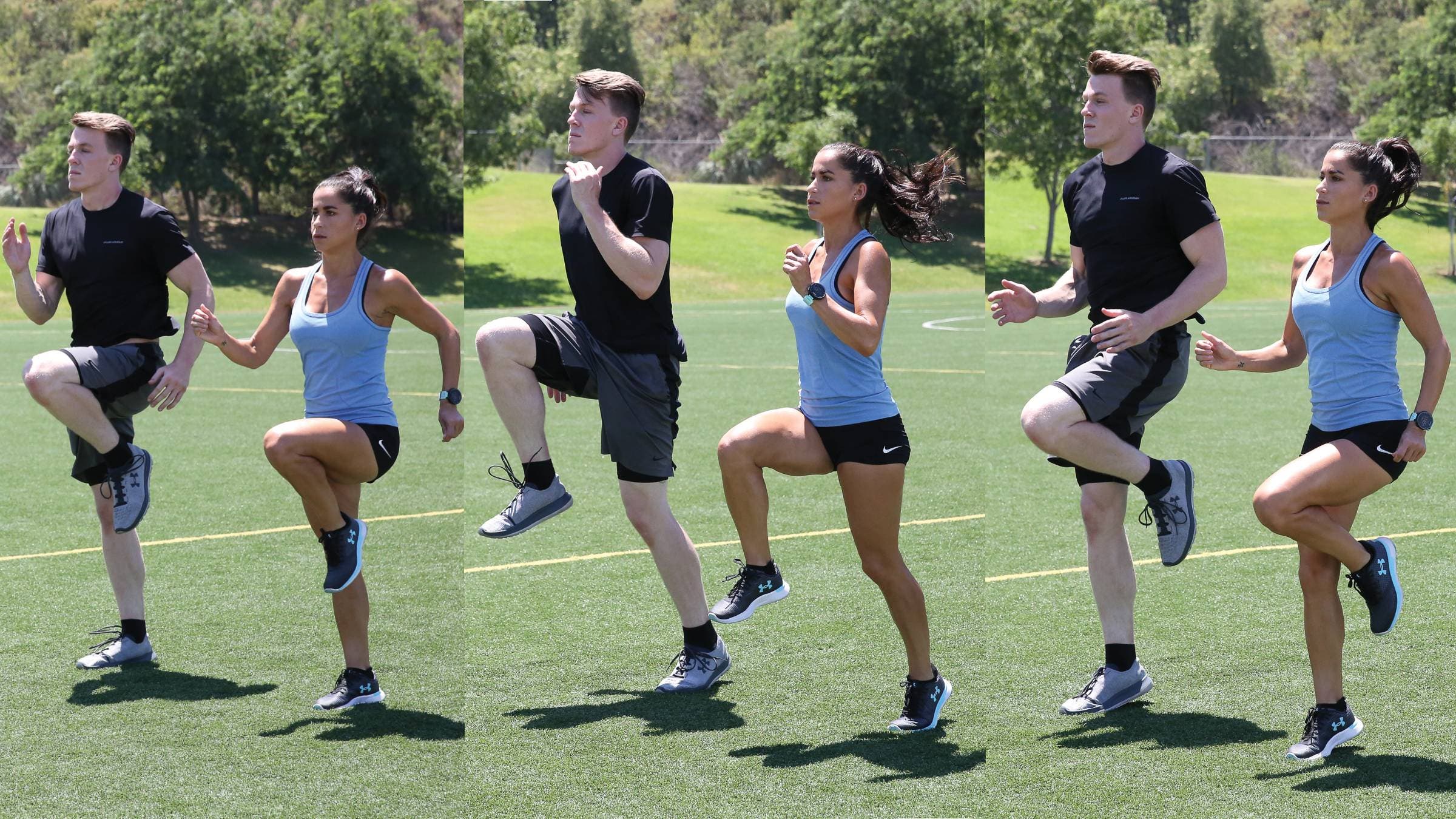
Photo: Diana Hernandez
This drill targets your neuromuscular system and works two key aspects of maximum velocity: elastic recoil and knee lift. First, you drive the ball of your foot into the ground, generating a high vertical force that results in equally large elastic energy storage in your Achilles and arch. Next, you release this energy to fuel your leg’s bounce back to high knee lift position, at which point a stretch reflex in your glutes and hamstrings slingshots your thigh in the reverse direction.
1 rep of 20–60 yards
- After jogging a few steps, drive your right knee upward.
- Forcefully bring your right leg down (don’t just let it fall), landing on the ball of your foot. Simultaneously lift your left knee.
- Press your landing foot down until your heel almost taps the ground, then allow elastic recoil from your Achilles and arch to fuel a “bounce” as you drive your knee to waist height or better. As one knee rises, the opposite foot comes down.
- After completing the drill, jog back to your start line, then immediately perform a stride at 90% effort (same distance as drill), followed by a walk back to the start line.
Quick Feet
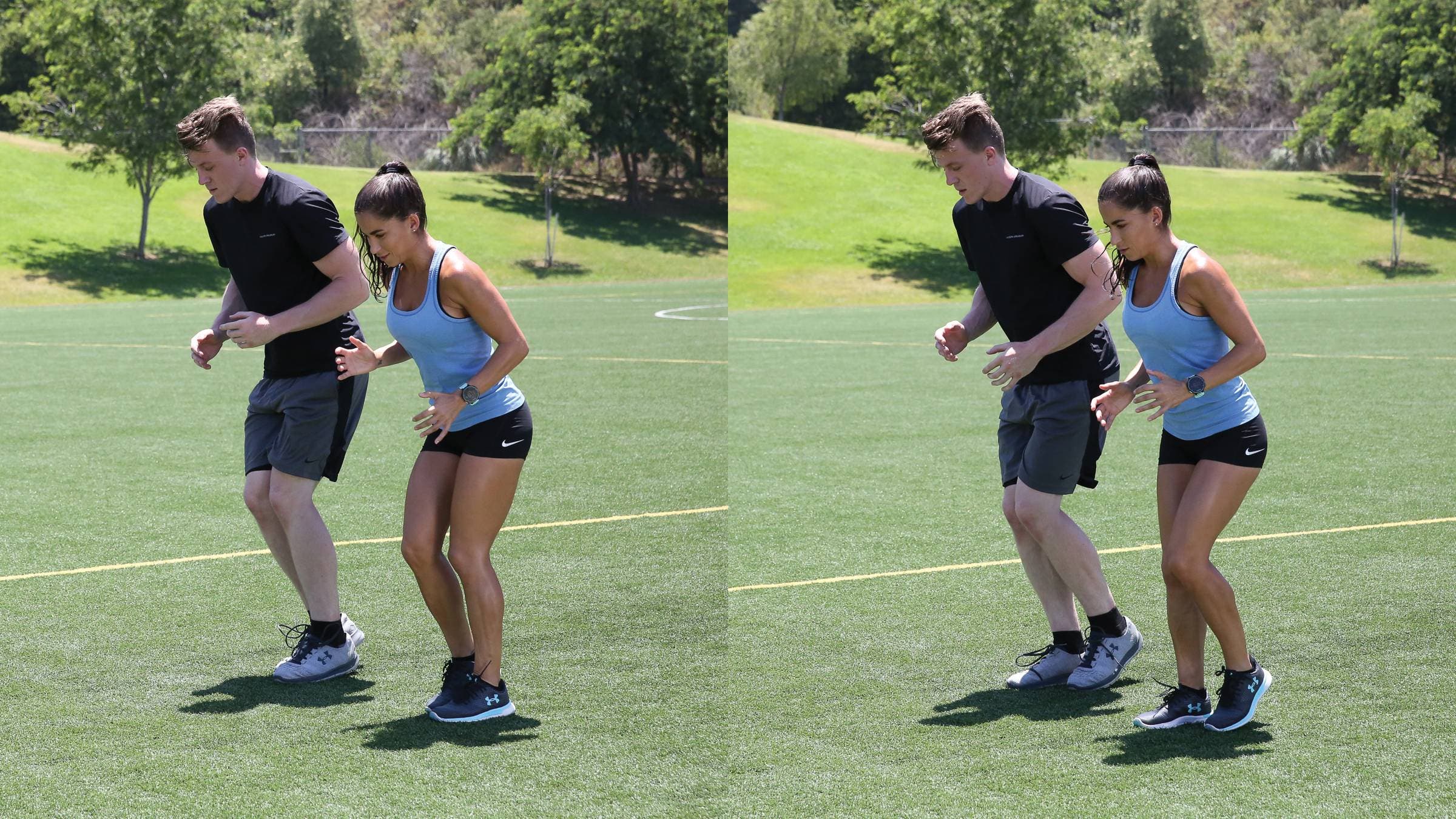
Photo: Diana Hernandez
This drill does double duty for your training. You’ll practice reduced contact time to increase your running speed, while simultaneously training foot speed for agility. You’ll also give your tibialis anterior and peroneal group (outside calf) muscles a solid workout—if you do this drill correctly, those muscles will be burning.
1 rep of 20–30 yards
- Begin with your feet hip-width apart, elbows bent at 90° and held loosely at your sides.
- Lift your right foot and quickly step forward a few inches. The bottom of your shoe should not rise more than 1–3 inches off the ground.
- Repeat with your left foot, and then with your right foot, etc., shuffling as quickly as you can for 20–30 yards.
- After completing the drill, jog back to your start line, then immediately perform a stride at 90% effort (same distance as drill), followed by a walk back to the start line.
Quick Hops

Photo: Diana Hernandez
This plyometric drill is perfect for practicing the quick bursts of combined vertical and horizontal force you’ll need to produce at maximum velocity. Some athletes call these bunny hops. But don’t let the cute name fool you. These deliver a major burn to your quads. If you start losing form—and it goes quick with this drill—it’s time to jog back to the start line.
1 rep of 20–30 yards
- Begin with your feet hip-width apart, elbows at 90°, arms at your sides.
- Spring forward with both feet, focusing on horizontal—not vertical—motion. Keep your jumps low to the ground (a few inches’ clearance is fine).
- As soon as you land, jump again, keeping a quick rhythm as you hop for the remainder of the drill.
- After completing the drill, jog back to your start line and immediately perform a stride at 90% effort (same distance as drill), followed by a walk back to the start line.
Butt Kicks
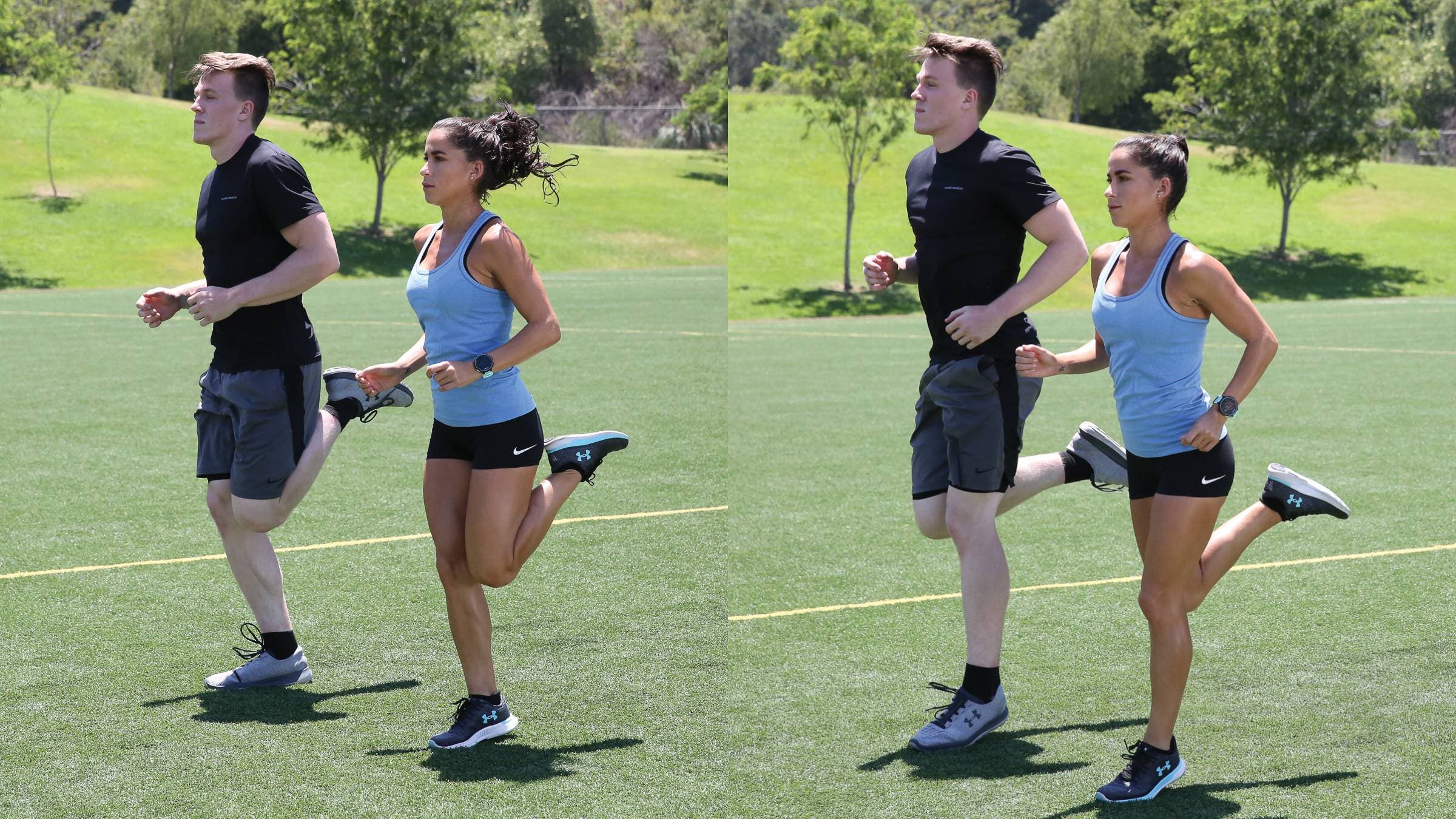
Photo: Diana Hernandez
At maximum velocity, your heel rises toward your glutes due to a stretch reflex, forward momentum, and a hinge-like action at your knee, the latter of which allows force created by the former to swing your lower leg backward. So why perform a butt kicks drill that has a completely different genesis for movement, relying on the hamstrings’ concentric contraction? One, because you’ll strengthen muscles involved in butt-kicking, and two, because it increases your quadriceps’ range of motion and sprint-readiness.
1 rep of 20–60 yards
- Run tall, stay on the balls of your feet, and keep your thighs perpendicular to the ground as you quickly lift one heel toward your glutes—either touch or come as close as you can. Do the same with your opposite leg.
- Work your arms in a running motion throughout the drill.
- After completing the drill, jog back to the start line, then immediately perform a stride at 90% effort (same distance as drill), followed by a walk back to the start line.
Straight-Leg Bounding
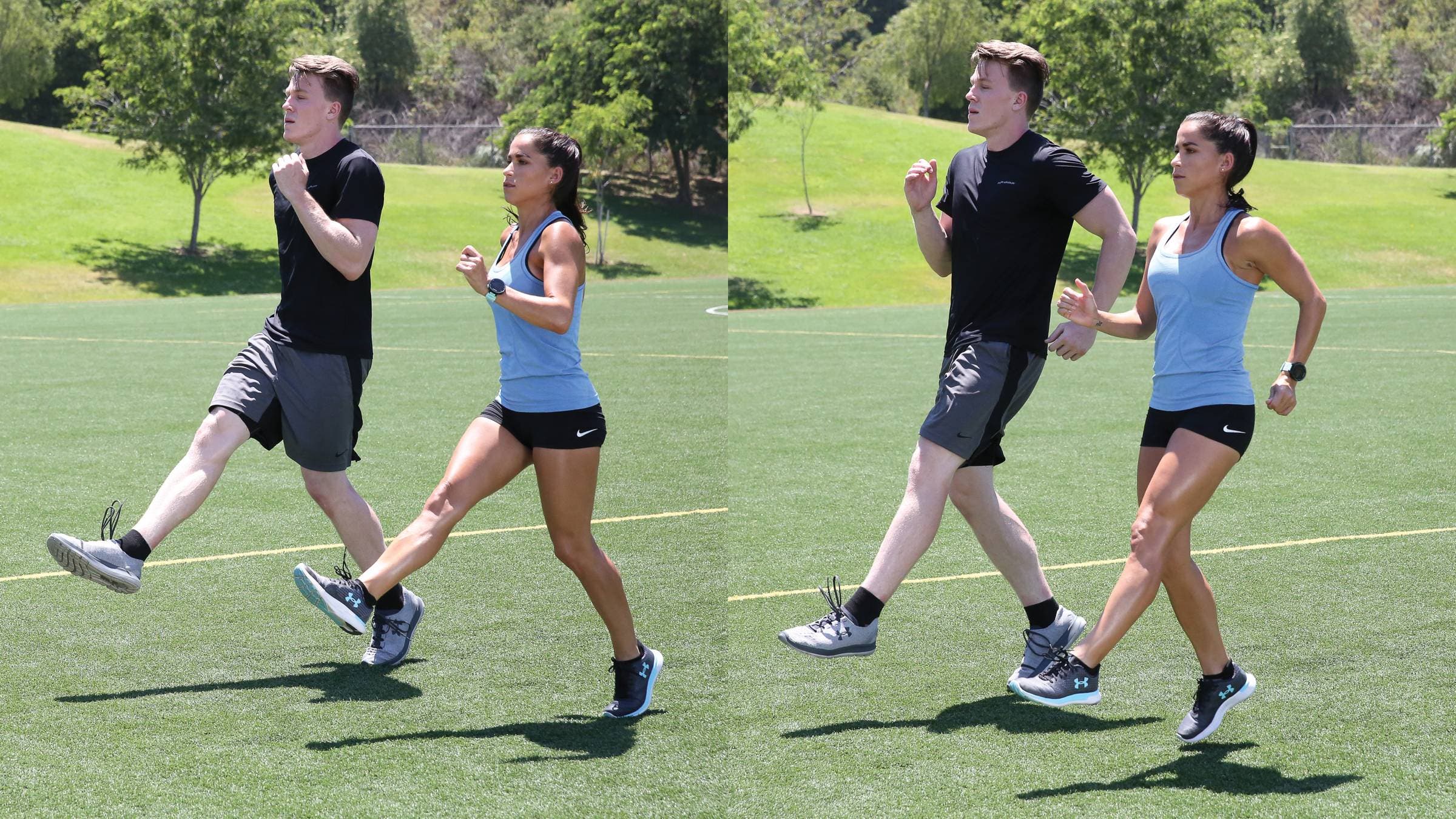
Photo: Diana Hernandez
This is a great exercise for activating your glutes (the muscle group that sprinters refer to as the engine) and your hamstrings (the muscle group most sprint researchers credit with driving maximum velocity). You’ll also activate your quadriceps, making this an exercise that pays equal dividends for hip extension and hip flexion.
1–2 reps of 20–40 yards
- Begin with a few yards of jogging.
- Extend both legs fully at the knee (i.e., straighten your legs). Lift your right leg, utilizing your hip flexors. Simultaneously, drive down your left leg, using your glutes and hamstrings for a powerful hip extension.
- Be sure to land on the ball of your foot—stay off your heels throughout the exercise.
- Next, lift your left leg and drive down your right.
Adapted from SpeedRunner: 4 Weeks to Your Fastest Leg Speed in Any Sport by Pete Magill with permission of VeloPress.